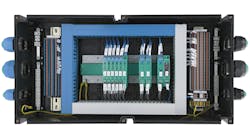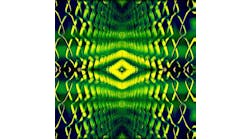Machine designers often encounter situations where potentially explosive materials are generated during operation. Materials such as aluminum, titanium and wood are often used in industry but can become highly explosive when finely divided.
Common fabrication methods such as milling, turning, machining and polishing often result in the generation of fines and dust. Such applications can create a hazardous location—an area where an explosive atmosphere might exist. These locations pose unique risks and require special consideration to ensure safety.
Hazardous locations are subdivided into several categories. These categories identify the kind of fuel, the degree of risk and other relevant characteristics.
- The first important characteristic is the kind of fuel, or class. These include Class I (gases), Class II (dusts) and Class III (fibers/flyings). Many machine applications end up generating combustible dusts, making them Class II.
- The second characteristic describes the degree of risk. To simplify, Div. 1 locations are high-risk areas where fuel is normally present. Div. 2 locations are lower-risk areas where fuel is not normally present. Divisions are progressive: for example, a machine might have a Div. 1 area internally, but be classified as Div. 2 around the cabinet.
- The next characteristic concerns the ability of specific fuels to be ignited from an electrical spark. As there are a large number of possible fuels, various fuel groups have been created to consolidate fuels of similar characteristics. Groups A though D comprise gas fuels, while Groups E through G comprise dust fuels.
- The final characteristic is the ability of fuels to be ignited from a hot surface. This is handled either by a temperature rating or by a T-code. T-codes range from T1 (hottest) to T6 (coolest), with T6 being the safest.
Also read: Device protection in the danger zone
Production of combustible dust is often an inevitable consequence of machine processes. Options may be available to reduce or even eliminate the hazardous location, such as:
- Relocating electrical equipment outside the hazardous location. A motor might be moved outside the machine cabinet by using a mechanical linkage.
- Removing the fuel. This can often be accomplished by effective dust collectors, suitably rated for handling explosive dusts, coupled with an effective customer housekeeping program. If dust collection fails, machines may need to be shut down.
In cases where electrical equipment must be placed in a hazardous location, various techniques can be used to ensure safety. These include intrinsically safe, dust-ignition-proof, purge/pressurized and others.
- Intrinsic safety relies on limiting electrical energy so that no ignition is possible. This is well-suited to small, low-power devices but can’t be applied to high-power items such as motors.
- Dust-ignition-proof equipment uses heavy metal enclosures to contain any explosion. This can be useful for items such as motors but isn’t especially useful for sensors or controls, and it’s often expensive.
- Purge and pressurization keeps fuel away by forcing clean air or gas into the enclosure. This obviously requires an air source, such as compressed air, along with a specially certified purge controller, and it’s most useful for large and complex equipment.
Most techniques don’t provide any protection for wiring or cabling, making them potential sources of ignition. Rigid and inflexible wiring solutions such as conduit, armored cable, certified fittings and certified connectors are often required to address this risk, which severely limits the options available to the machine designer.
On the other hand, intrinsically safe wiring poses no risk, and so can be any type of cable or connector suitable for the application. Shielded cable or cable with shielded pairs is sometimes required, but this isn’t usually difficult. This makes intrinsically safe equipment a particularly attractive option where moving or serviceable parts are involved.
Intrinsic safety is usually accomplished by placing an intrinsically safe barrier between a non-intrinsically safe system, such as a controller, and an intrinsically safe device, such as a sensor. The barrier functions to limit the electrical energy that enters the hazardous area to levels that can’t cause an ignition.
Barriers are usually specifically designed for the type of signal, such as power, voltage, current, I/O or switch or relay outputs, and they might have one or multiple outputs. They are typically installed in an area where there is no fuel, such as outside the machine enclosure, and in strict accordance with the installation instructions and the NEC.
To function properly and ensure safety, the barrier and device must be compatible. In some cases a device must use a specific barrier; in other cases, devices and barriers can be matched via the use of electrical ratings called entity parameters, which define the safety ratings on both sides. Any two devices with matching entity parameters can be used together without risk of ignition.
Devices and barriers are certified by recognized agencies for use in specific countries, such as the United States, Canada, the European Union (ATEX) and elsewhere (IEC). These ratings are not interchangeable, making it critical to ensure that all devices carry the right ratings for the intended location of use.
Not all devices are available in an intrinsically safe version, making it a challenge to the machine designer to locate appropriate devices. However, once located, intrinsically safe devices usually don’t require any special installation techniques or precautions, making them relatively easy to integrate.
Intrinsic safety allows highly useful devices, such as sensors and switches, to be integrated into all types of hazardous-location machinery without the need to use cumbersome protective techniques or unsuitable wiring methods. Instead, safety can be readily and easily achieved simply by using a suitable intrinsically safe barrier in conjunction with approved intrinsically safe devices. This reduces cost, complexity and time to market while preserving the functionality of the machine.



